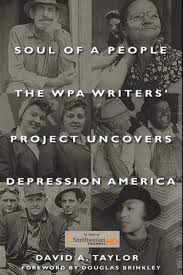 No, it’s not a strange version of literary “six degrees of separation”, but it is among the many questions David Taylor, sets out to answer in Soul of a People: The WPA Writers’ Project Uncovers Depression America. The answer, then, to the riddle is that all three were employed by the WPA Writers’ Project in the 1930s. They, and countless other writers, editors, and historians, set out on the ambitious project and created the sprawling series of WPA guides that persist as used bookstore gold until today.
No, it’s not a strange version of literary “six degrees of separation”, but it is among the many questions David Taylor, sets out to answer in Soul of a People: The WPA Writers’ Project Uncovers Depression America. The answer, then, to the riddle is that all three were employed by the WPA Writers’ Project in the 1930s. They, and countless other writers, editors, and historians, set out on the ambitious project and created the sprawling series of WPA guides that persist as used bookstore gold until today.
If you’ve never encountered a WPA guide before, I highly recommend seeking one out. Far from the generic museum advice and restaurant recommendations that you may find in contemporary guidebooks, these guides delve much deeper into the history and culture of the states, cities, and regions that they profile. The D.C. guide contains an extensive profile on the U Street neighborhood – not exactly a tourist destination at the time – but a stronghold of African American culture, and a site deemed worth exploring by the guide’s author.
In a culture where the humanities and the written word are valued less and less. This book seems especially important in the glimpse that it gives into how artists were valued. The WPA was borne from an effort to put Americans back to work, most specifically the blue collar workers, but also anyone who was teetering dangerously close to abject poverty. It’s incredibly telling that, among these workers deemed worth saving, writers were included.
David Taylor writes, “When Nelson Algren said that the Project gave hope to people who had lost it, he was not being melodramatic. The Writers’ Project set a trampoline under many thousands, writers and nonwriters, who would have otherwise hit the pavement.” I wonder if similar economic circumstances were to occur today, the same “trampoline” would be set under today’s writers.
When Taylor joins us this evening, this is just one of the many questions we’ll likely touch on. To formulate your own answers, check out his work, either in book form, or as a documentary produced by the Smithsonian channel.
— Ariel Martino
